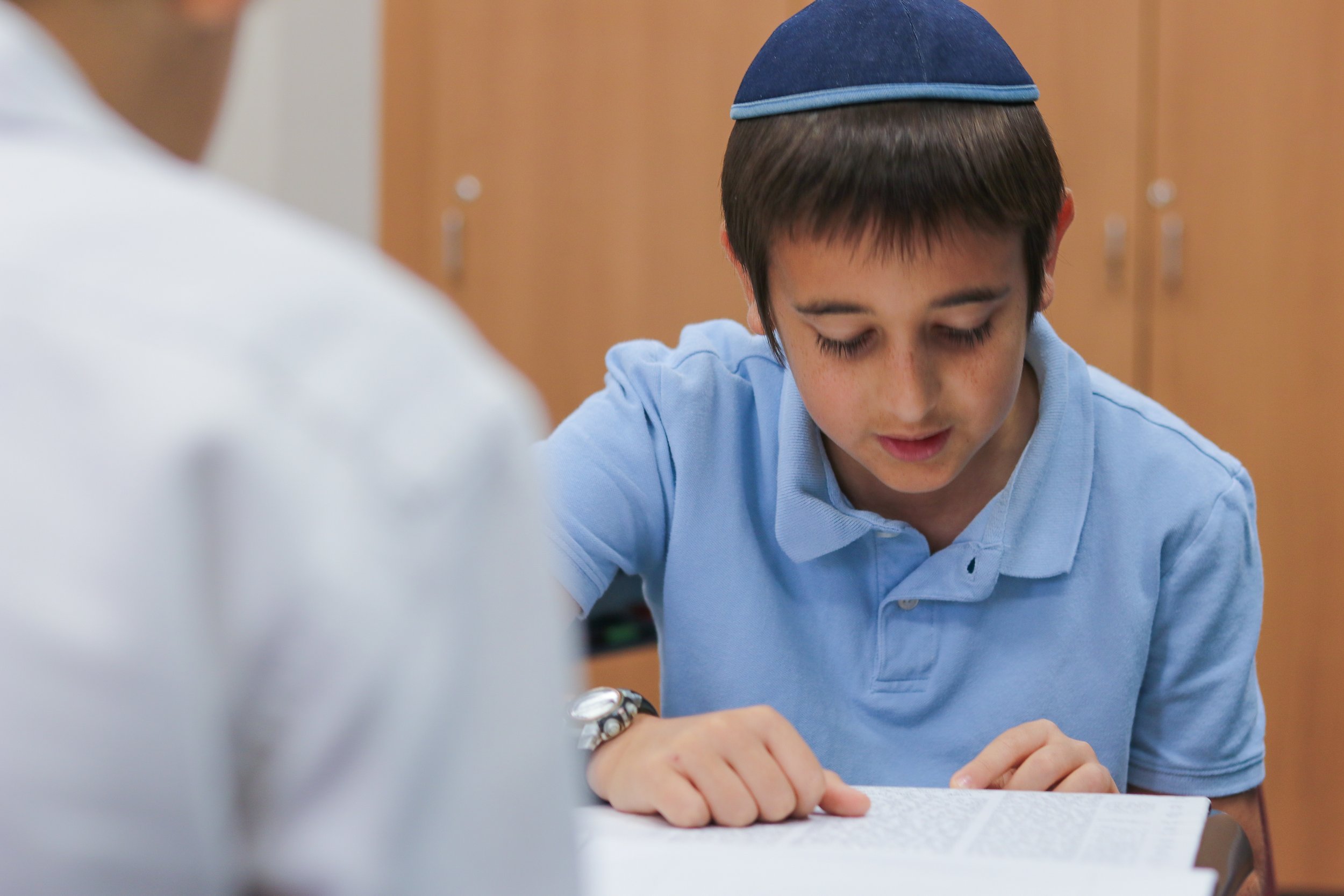
Judaic Studies
Judaic Studies
At Torah Day School, we infuse our Judaic curriculum with the yiras Shemayim and ahavas Yisroel that our people have always cultivated.
From holidays and customs to halacha and Chassidus, our teachers are living examples of the lessons they teach. The joy and pride that they exude is infectious. They demonstrate to our students trust in Hashem, social justice in action, innovative thought when faced with new challenges, and grit during times of difficulty.
We believe that through a healthy awareness of Jewish history and tradition, a child is opened to a greater sense of self, of the past, and of possibilities. Thus, the students learn to make well-grounded ethical decisions for themselves and their community.
TDS graduates go on to spread kindness and demonstrate the values needed in civil society. They become leaders and active participants in the Jewish community, raising families who grow and thrive in the Jewish way.
Judaic Curriculum
-
Chumash: The Five Books of Moses
The Chumash is the foundation of the Torah Day School curriculum. Chumash is taught daily throughout the elementary years. Chumash Breishit is completed by the end of fourth grade. Subsequently, Chumash Shemot, parts of Vayikra, Bamidbar and parts of Devarim are completed by the eighth grade.
Navi: The Prophets
It is generally accepted that children should complete the Neviim Rishonim, early prophets, by the end of elementary school.
Navi is studying in the following sequence:
4th grade-Yehoshua-Joshua
5th grade- Shoftim-Judges
6th -8th grade- Shmuel I, Shmuel II, Malachim I
The Mishna: The codified oral tradition
The study of Mishna is both a prelude to the Talmud as well as an independent pursuit. The cognitive process required is on a higher and more complex level than that required for Chumash study, yet for more than a millennium and a half, Jewish children successfully assimilated the learning process from a very early age. It is obviously necessary to begin with the simple lest concepts, many of which any child from an observant home is familiar with (the Shabbat and festivals, etc) and progress from there to more complex issues. Mishna is begun at the fifth or sixth grade.
The Talmud or Gemara
The vast volume of Talmudic literature has become known metaphorically as “the sea of Talmud” because its pursuit is an endless process. The study of the Talmud starts at a tender age; its mastery is a lifetime quest. Yet even when a day school education may not include high school, children should be exposed to the delicate intricacies of Talmudic logic on a basic level. This has traditionally been limited to boys. Talmudic studies start at 5th grade.
-
Tefilla: Prayer
Every child must learn how to pray to Hashem and why. This process starts in the preschool and intensifies when a child learns to read from a Siddur. By fifth grade, a child should pray most of the basic morning service, Shacharis.
The Shabbos and Yom Tov
The Shabbat and festivals are basic to Jewish observances. Without a thorough knowledge of their meaning and their laws and customs, a Jew cannot function. The process of learning about the Shabbos and festivals starts early with basic child-friendly observances, but progresses to a full Halachic understanding.
Brachot: Blessings
Every day school student should be able to recite the correct blessing over food and periodic special occasions, which also require an acknowledgement of G‑d’s benevolence. They should have mastered all basic Brachos including Birkas Hamazon, grace after meals, by heart, by the fifth grade.
Kashrut: Dietary Laws
Though many of the dietary laws are quite complex, the basic “Halachos” are such that even a young student should be able to be fully knowledgeable of the basic laws. It is not just a matter of what is Kosher, but also why and how it becomes Kosher. By the junior high grades, a student should know what it takes to make a kitchen kosher, and what renders it or any utensil “Treif”. A student should know the biblical references to the laws of Kashrus as well.
S.T.A.M: Sefer Torah, Tefilin, Mezzuzah (and laws of Tzitzis).
All students should become familiar with the laws of sacred object such as a Torah (and Bet Knesset), Tefillin and Mezzuzah. They should have a fundamental understanding of how they are made and what makes them Kosher. The same is true of Tzitzit and other sacred objects.
Bein Adam L’Chavero: Between man and neighbor
All children should study the Jewish laws relating to interpersonal relationships and personal morality. This includes the laws pertaining to property (lost and found), Tzedakah as well as “Kibud Av V’eim”- honoring parents (and teachers). Every Jewish child should be taught about the sense of community within the Jewish world, as well as detailed Jewish laws and personal conduct.
Dinei Harechush: The Halachos (Jewish laws) governing property
What are the rights and responsibilities of owing property? What is the nature of our responsibility towards the property of another? Though the body of these laws is immense, children need not to be exposed to the basic of property laws. This includes: being responsible for damage one causes to the property of another, as well as the rights of an accidental damager; the laws of returning a lost article, when and to whom; the laws of a borrower and lender; the obligation to give Tzedakah; and much more.
Eretz Yisrael: The Land of Israel
The special relationship, which ties us to Israel, should be carefully nurtured. Every child is taught that Israel is the Jewish homeland and about it special sacredness. In addition, children should be familiarized with the special “Halachos” pertaining to Israel and its inhabitants.
-
Effective Hebrew-language instruction is another key component of Judaic studies, as that is the key language spoken by Jews throughout the world. The school's Hebrew instructors carry certification from Israel to teach the language. They teach Hebrew in the context of modern-day conversation so that students can learn how their contemporaries in Israel speak. The structure and vocabulary of the language is taught in an immersion-based method, so that students do not memorize by rote but instead learn to converse so that their knowledge is ingrained in their minds. Fluency in Hebrew is a typical trait of our middle-school students. Our eighth-grade students are fluent in conversational, modern-day Hebrew.
All Jewish schools teach the Hebrew language. We pray in Lashon Hakodesh; it is the language of our sacred texts and the tremendous body of Jewish knowledge. All children should be reading with a degree of fluency and accuracy by the end of first grade. They should all learn to write Hebrew simultaneously.
Students in the early grades should be able to write a simple grammatically correct sentence in Hebrew. Their writing should become more complex as they develop more proficiency in the middle grades. They should be able to distinguish the tenses and genders, and conjugate simple verbs and decode nouns declensions correctly by middle school. By then, writing a short composition or poem should be a developing skill. Conversational Hebrew starts with our 2 year olds and continues through middle school. When our students travel to Israel, they can converse with confidence.
-
History - Divrei Yemei Yisrael: including both historical events and personalities as well as Jewish perspective.
Jewish history is much more than just a review of names, dates, places and events. It is a study of how we as a people developed, and the sages of our chain of tradition which stretches back to Har Sinai We cannot simply review historical data, but must help children understand stories of Jewish triumph over adversity of every form. Books alone can hardly convey the intensity with which a teacher must impart and inspire. While there is precious little time to properly treat three and a half millennia of Jewish history in a formal way, a teacher must weave history and the “hashkafa” perspective of the Jewish experience into all subjects in order to be able to do a credible job.
History taught in the elementary years weighs heavily in favor of ancient history: that of the biblical period, the second Beis Hamikdash and the Mishaic and Talmudic periods (1000 BCE to 500 CE). Proper treatment of the medieval and subsequent periods are generally left to the high schools.
Students should be able to recall the chronological order of the Jewish periods within Jewish history. They should be able to identify historical figures with which the events are associated.
More importantly, however, is the development of the realization that the status of Jewish historical figures cannot be equated with that of their secular counterparts when we include Biblical personalities and Sages of the subsequent periods. Their “hashkafa” of Jewish history should begin to show sensitivity for the sacredness of the Jewish people.


